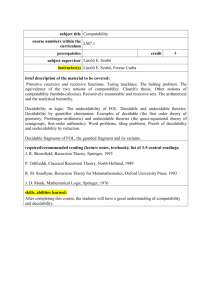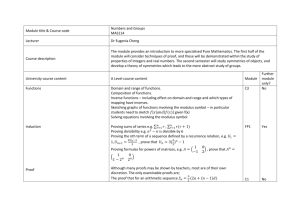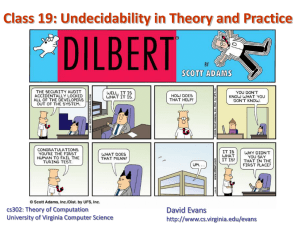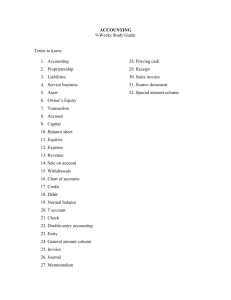Turing Machines - University of Virginia
advertisement
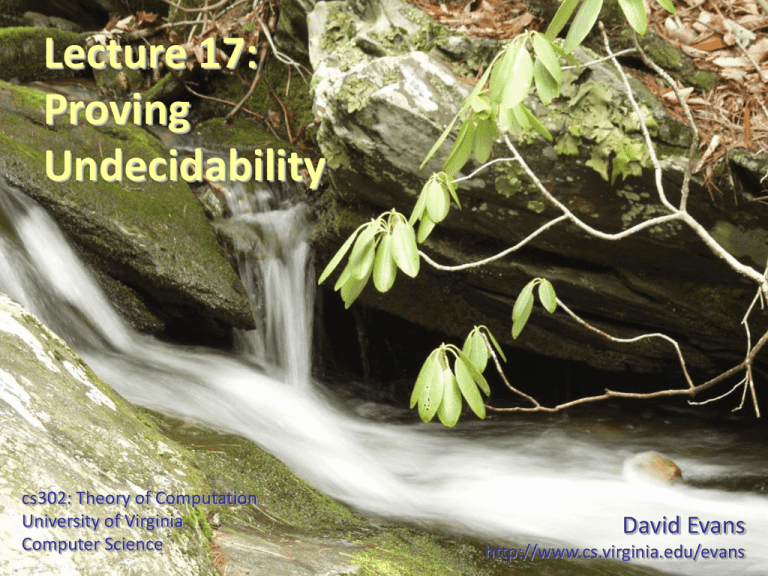
Lecture 17:
Proving
Undecidability
cs302: Theory of Computation
University of Virginia
Computer Science
David Evans
http://www.cs.virginia.edu/evans
Proofs of Decidability
How can you prove a language is decidable?
Lecture 17: Proving Undecidability
2
What Decidable Means
A language L is decidable if there exists a TM
M such that for all strings w:
– If w L, M enters qAccept.
– If w L, M enters qReject.
To prove a language is decidable, we can
show how to construct a TM that decides it.
For a correct proof, need a convincing argument that the
TM always eventually accepts or rejects any input.
Lecture 17: Proving Undecidability
3
Proofs of Undecidability
How can you prove a language is undecidable?
Lecture 17: Proving Undecidability
4
Proofs of Undecidability
To prove a language is undecidable, need
to show there is no Turing Machine that
can decide the language.
This is hard: requires reasoning about all possible TMs.
Lecture 17: Proving Undecidability
5
Proof by Reduction
X
1. We know X does not exist.
(e.g., X = a TM that can decide ATM )
2. Assume Y exists.
(e.g., Y = a TM that can decide B)
3. Show how to use Y to make X.
Y
Y
4. Since X does not exist, but Y could be used to
make X, then Y must not exist.
Lecture 17: Proving Undecidability
6
Reduction Proofs
A
reduces to
B
means
can be used to make
Y
X
that can solve A
that can solve B
Hence, A is not a harder problem than B.
The name “reduces” is confusing: it is in the
opposite direction of the making.
Lecture 17: Proving Undecidability
7
Converse?
A reduces to B
can be used to make
Y
that can solve B
X
that can solve A
A is not a harder problem than B.
Does this mean B is as hard as A?
No! Y can be any solver for B. X is one solver for A.
There might be easier solvers for A.
Lecture 17: Proving Undecidability
8
Reduction Pitfalls
• Be careful: the direction matters a great deal
– Showing a machine that decides B can be used to
build a machine that decides A shows that A is not
harder than B.
– To show equivalence, need reductions in both
directions.
• The transformation must involve only things
you know you can do: otherwise the
contradiction might be because something
else doesn’t exist.
What does can do mean here?
Lecture 17: Proving Undecidability
9
What “Can Do” Means
• The transformations in a reduction proof are
limited by what you are proving
• For undecidability proofs, you are proving
something about all TMs: the reduction
transformations are anything that a TM can do
that is guaranteed to terminate
• For complexity proofs (later), you are proving
something about how long it takes: the time it
takes to do the transformation is limited
Lecture 17: Proving Undecidability
10
The Halting Problem
HALTTM = { <M, w> | M is a TM description
and M halts on input w }
Alternate statement as problem:
Input: A TM M and input w
Output: True if M halts on w, otherwise False.
Lecture 17: Proving Undecidability
11
Is HALTTM Decidable?
• Possible “Yes” answer: Prove it is decidable
Design a TM that can decide HALTTM
• Possible “No” answer: prove it is undecidable
Show that no TM can decide HALTTM
Show that a TM that could decide HALTTM could be used
to decide ATM which we already proved is undecidable.
Lecture 17: Proving Undecidability
12
Acceptance Language
ATM = { <M, w> | M is a TM description
and M accepts input w }
We proved ATM is undecidable last class.
Since we know ATM is undecidable, we can show a new
language B is undecidable if a machine that can decide B
could be used to build a machine that can decide ATM.
Lecture 17: Proving Undecidability
13
Reducing ATM to HALTTM
HALTTM = { <M, w> | M is a TM description
and M halts on input w }
ATM = { <M, w> | M is a TM description
and M accepts input w }
<M, w> is in ATM if and only if:
M halts on input w
and when M halts it is in accepting state.
Lecture 17: Proving Undecidability
14
Deciding ATM
• Assume HALTTM is decidable.
• Then some TM R can decide HALTTM.
• We can use R to build a machine that decides ATM:
– Simulate R on <M, w>
– If R rejects, it means M doesn’t halt: reject.
– If R accepts, it means M halts:
• Simulate M on w, accept/reject based on M’s accept/reject.
Since any TM that decides HALTTM could be used to build
a TM that decides ATM (which we know is impossible) this
proves that no TM exists that can decide HALTTM .
Lecture 17: Proving Undecidability
15
Equivalence of DFA D and TM M
EQDM = { <D, T > | D is a DFA description,
T is a TM description
and L(T) = L(D) }
Is EQDM decidable?
Lecture 17: Proving Undecidability
16
EQDM
Is Undecidable
• Suppose R decides EQDM.
• Can we use R to decide HALTTM?
HALTTM = { <M, w> | M is a TM description
and M halts on input w }
EQDM = { <D, T > | D is a DFA description,
T is a TM description
and L(T) = L(D) }
Given M and w, how can you construct D and T so
R(<D, T>) tells you if M halts on w?
Lecture 17: Proving Undecidability
17
EQDM
Is Undecidable
HALTTM = { <M, w> | M is a TM description
and M halts on input w }
EQDM = { <D, T > | D is a DFA description,
T is a TM description
and L(T) = L(D) }
D = DFA that accepts all strings.
T = TM that ignores input and simulates M on w,
and if simulated M accepts or rejects, accept.
Lecture 17: Proving Undecidability
18
EQDM
Is Undecidable
HALTTM = { <M, w> | M is a TM description
and M halts on input w }
EQDM = { <D, T > | D is a DFA description,
T is a TM description
and L(T) = L(D) }
D = DFA that rejects all strings.
T = TM that ignores input and simulates M on w,
and if simulated M accepts or rejects, reject.
Lecture 17: Proving Undecidability
19
Rice’s Theorem
Henry Gordon Rice, 1951
Any nontrivial property about the
language of a Turing machine is
undecidable.
Nontrivial means the property is true for
some TMs, but not for all TMs.
Lecture 17: Proving Undecidability
20
•
•
•
•
•
Does TM M accept any strings? Undecidable
Does TM M accept all strings? Undecidable
Does TM M accept “Hello”? Undecidable
Does TM M1 accept more strings than TM M2?
Does TM M take more than 1000 steps to
process input w? Decidable
• Does TM M1 take more steps than TM M2 to
process input w? Undecidable
Lecture 17: Proving Undecidability
21
Undecidable
Which of these are Undecidable?
Next Class
• Examples of some problems we actually care
about that are undecidable
• Are there any problems that we don’t know if
they are decidable or undecidable?
• PS5 Due next Tuesday (April 1)
• Exam 2 in two weeks
Lecture 17: Proving Undecidability
22
